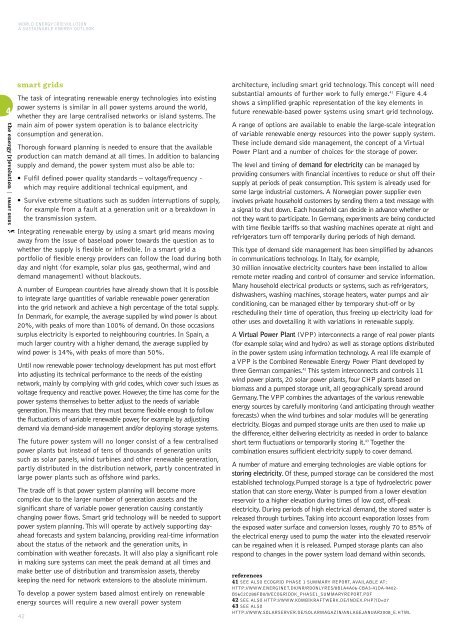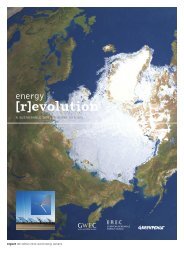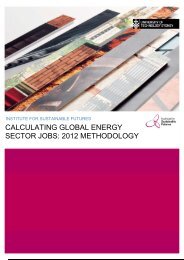download the mexico energy revolution scenario
download the mexico energy revolution scenario
download the mexico energy revolution scenario
You also want an ePaper? Increase the reach of your titles
YUMPU automatically turns print PDFs into web optimized ePapers that Google loves.
WORLD ENERGY [R]EVOLUTION<br />
A SUSTAINABLE ENERGY OUTLOOK<br />
4<br />
<strong>the</strong> <strong>energy</strong> [r]evolution | SMART GRIDS<br />
smart grids<br />
The task of integrating renewable <strong>energy</strong> technologies into existing<br />
power systems is similar in all power systems around <strong>the</strong> world,<br />
whe<strong>the</strong>r <strong>the</strong>y are large centralised networks or island systems. The<br />
main aim of power system operation is to balance electricity<br />
consumption and generation.<br />
Thorough forward planning is needed to ensure that <strong>the</strong> available<br />
production can match demand at all times. In addition to balancing<br />
supply and demand, <strong>the</strong> power system must also be able to:<br />
• Fulfil defined power quality standards – voltage/frequency -<br />
which may require additional technical equipment, and<br />
• Survive extreme situations such as sudden interruptions of supply,<br />
for example from a fault at a generation unit or a breakdown in<br />
<strong>the</strong> transmission system.<br />
Integrating renewable <strong>energy</strong> by using a smart grid means moving<br />
away from <strong>the</strong> issue of baseload power towards <strong>the</strong> question as to<br />
whe<strong>the</strong>r <strong>the</strong> supply is flexible or inflexible. In a smart grid a<br />
portfolio of flexible <strong>energy</strong> providers can follow <strong>the</strong> load during both<br />
day and night (for example, solar plus gas, geo<strong>the</strong>rmal, wind and<br />
demand management) without blackouts.<br />
A number of European countries have already shown that it is possible<br />
to integrate large quantities of variable renewable power generation<br />
into <strong>the</strong> grid network and achieve a high percentage of <strong>the</strong> total supply.<br />
In Denmark, for example, <strong>the</strong> average supplied by wind power is about<br />
20%, with peaks of more than 100% of demand. On those occasions<br />
surplus electricity is exported to neighbouring countries. In Spain, a<br />
much larger country with a higher demand, <strong>the</strong> average supplied by<br />
wind power is 14%, with peaks of more than 50%.<br />
Until now renewable power technology development has put most effort<br />
into adjusting its technical performance to <strong>the</strong> needs of <strong>the</strong> existing<br />
network, mainly by complying with grid codes, which cover such issues as<br />
voltage frequency and reactive power. However, <strong>the</strong> time has come for <strong>the</strong><br />
power systems <strong>the</strong>mselves to better adjust to <strong>the</strong> needs of variable<br />
generation. This means that <strong>the</strong>y must become flexible enough to follow<br />
<strong>the</strong> fluctuations of variable renewable power, for example by adjusting<br />
demand via demand-side management and/or deploying storage systems.<br />
The future power system will no longer consist of a few centralised<br />
power plants but instead of tens of thousands of generation units<br />
such as solar panels, wind turbines and o<strong>the</strong>r renewable generation,<br />
partly distributed in <strong>the</strong> distribution network, partly concentrated in<br />
large power plants such as offshore wind parks.<br />
The trade off is that power system planning will become more<br />
complex due to <strong>the</strong> larger number of generation assets and <strong>the</strong><br />
significant share of variable power generation causing constantly<br />
changing power flows. Smart grid technology will be needed to support<br />
power system planning. This will operate by actively supporting dayahead<br />
forecasts and system balancing, providing real-time information<br />
about <strong>the</strong> status of <strong>the</strong> network and <strong>the</strong> generation units, in<br />
combination with wea<strong>the</strong>r forecasts. It will also play a significant role<br />
in making sure systems can meet <strong>the</strong> peak demand at all times and<br />
make better use of distribution and transmission assets, <strong>the</strong>reby<br />
keeping <strong>the</strong> need for network extensions to <strong>the</strong> absolute minimum.<br />
To develop a power system based almost entirely on renewable<br />
<strong>energy</strong> sources will require a new overall power system<br />
42<br />
architecture, including smart grid technology. This concept will need<br />
substantial amounts of fur<strong>the</strong>r work to fully emerge. 41 Figure 4.4<br />
shows a simplified graphic representation of <strong>the</strong> key elements in<br />
future renewable-based power systems using smart grid technology.<br />
A range of options are available to enable <strong>the</strong> large-scale integration<br />
of variable renewable <strong>energy</strong> resources into <strong>the</strong> power supply system.<br />
These include demand side management, <strong>the</strong> concept of a Virtual<br />
Power Plant and a number of choices for <strong>the</strong> storage of power.<br />
The level and timing of demand for electricity can be managed by<br />
providing consumers with financial incentives to reduce or shut off <strong>the</strong>ir<br />
supply at periods of peak consumption. This system is already used for<br />
some large industrial customers. A Norwegian power supplier even<br />
involves private household customers by sending <strong>the</strong>m a text message with<br />
a signal to shut down. Each household can decide in advance whe<strong>the</strong>r or<br />
not <strong>the</strong>y want to participate. In Germany, experiments are being conducted<br />
with time flexible tariffs so that washing machines operate at night and<br />
refrigerators turn off temporarily during periods of high demand.<br />
This type of demand side management has been simplified by advances<br />
in communications technology. In Italy, for example,<br />
30 million innovative electricity counters have been installed to allow<br />
remote meter reading and control of consumer and service information.<br />
Many household electrical products or systems, such as refrigerators,<br />
dishwashers, washing machines, storage heaters, water pumps and air<br />
conditioning, can be managed ei<strong>the</strong>r by temporary shut-off or by<br />
rescheduling <strong>the</strong>ir time of operation, thus freeing up electricity load for<br />
o<strong>the</strong>r uses and dovetailing it with variations in renewable supply.<br />
A Virtual Power Plant (VPP) interconnects a range of real power plants<br />
(for example solar, wind and hydro) as well as storage options distributed<br />
in <strong>the</strong> power system using information technology. A real life example of<br />
a VPP is <strong>the</strong> Combined Renewable Energy Power Plant developed by<br />
three German companies. 42 This system interconnects and controls 11<br />
wind power plants, 20 solar power plants, four CHP plants based on<br />
biomass and a pumped storage unit, all geographically spread around<br />
Germany. The VPP combines <strong>the</strong> advantages of <strong>the</strong> various renewable<br />
<strong>energy</strong> sources by carefully monitoring (and anticipating through wea<strong>the</strong>r<br />
forecasts) when <strong>the</strong> wind turbines and solar modules will be generating<br />
electricity. Biogas and pumped storage units are <strong>the</strong>n used to make up<br />
<strong>the</strong> difference, ei<strong>the</strong>r delivering electricity as needed in order to balance<br />
short term fluctuations or temporarily storing it. 43 Toge<strong>the</strong>r <strong>the</strong><br />
combination ensures sufficient electricity supply to cover demand.<br />
A number of mature and emerging technologies are viable options for<br />
storing electricity. Of <strong>the</strong>se, pumped storage can be considered <strong>the</strong> most<br />
established technology.Pumped storage is a type of hydroelectric power<br />
station that can store <strong>energy</strong>. Water is pumped from a lower elevation<br />
reservoir to a higher elevation during times of low cost, off-peak<br />
electricity. During periods of high electrical demand, <strong>the</strong> stored water is<br />
released through turbines. Taking into account evaporation losses from<br />
<strong>the</strong> exposed water surface and conversion losses, roughly 70 to 85% of<br />
<strong>the</strong> electrical <strong>energy</strong> used to pump <strong>the</strong> water into <strong>the</strong> elevated reservoir<br />
can be regained when it is released. Pumped storage plants can also<br />
respond to changes in <strong>the</strong> power system load demand within seconds.<br />
references<br />
41 SEE ALSO ECOGRID PHASE 1 SUMMARY REPORT, AVAILABLE AT:<br />
HTTP://WWW.ENERGINET.DK/NR/RDONLYRES/8B1A4A06-CBA3-41DA-9402-<br />
B56C2C288FB0/0/ECOGRIDDK_PHASE1_SUMMARYREPORT.PDF<br />
42 SEE ALSO HTTP://WWW.KOMBIKRAFTWERK.DE/INDEX.PHP?ID=27<br />
43 SEE ALSO<br />
HTTP://WWW.SOLARSERVER.DE/SOLARMAGAZIN/ANLAGEJANUAR2008_E.HTML



![Energy [R]evolution - European Commission](https://img.yumpu.com/49109324/1/184x260/energy-revolution-european-commission.jpg?quality=85)


![5905 gp [eu rev]csfr4.qxd - Energy [R]evolution](https://img.yumpu.com/42305023/1/184x260/5905-gp-eu-revcsfr4qxd-energy-revolution.jpg?quality=85)


![5905 gp [eu rev]csfr4.qxd - Energy [R]evolution](https://img.yumpu.com/28729264/1/184x260/5905-gp-eu-revcsfr4qxd-energy-revolution.jpg?quality=85)